A Rookie Guide to Digital SLR Cameras
There comes a time in every point-and-shooter’s life when he or she wonders if there is more to photography than a
palm-sized block of aluminum stowed away in one’s pocket. The ultracompact point-and-shoot has come so far in
the last ten years that it’s tempting to write off DSLRs as largely irrelevant to most people’s lives, not offering
enoughutility to offset their bulky presence and hefty price tag. As soon as I bought my first truly great
ultracompact a few years ago, the Casio EX-Z750, I was in this boat.
what more could one possibly need? After eventually moving up to the excellent 7x zoom
Casio EX-V8, I told myself I would never need a DSLR.
But then I tried one for the first one, on loan from the fine folks at Nikon. ANikon D80. Seemingly
the “it” camera for the last couple of years. This article will not so much be a review of the D80,
but rather a guide for DSLR virgins considering purchasing their first full sized digital camera.
First and foremost, will you use it?
We all love toys. We all love expensive toys. But nobody loves an expensive toy they never use. If you think you’re
going to buy a DSLR and carry it around everywhere with you, you’re probably wrong. It’s heavy around your neck,
it’s easily lost or stolen if you put it down in a public place, and it will never blend into the fabric of your life like a
pocket camera will. In other words, be prepared to take it with you when you know you will be using it
(e.g. sightseeing, stormwatching, portrait-taking, etc), but at all other times, it will probably stay at home.
For this reason, even after you buy a DSLR, it’s probably good to keep your ultracompact point-and-shoot as your
standard carry-along camera. Even on vacations, there will be plenty of times when the smaller camera is the only
one on you at any given time. Again, I recommend the Casio EX-V8 as a fantastic ultracompact choice here. For
the last few years, Casio has made the best all-around point-and-shoots, in my opinion.
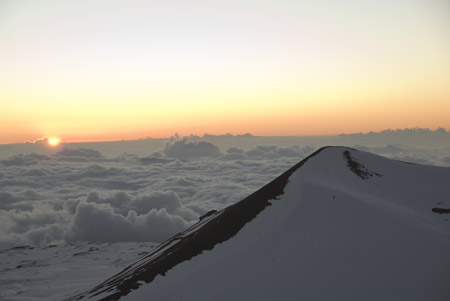
Sunset at the top of Mauna Kea, 13,796 feet above sea-level. The highest peak above the ocean floor in the world.
Definitely DSLR territory.
Nikon vs. Canon vs. everyone else
Most serious photographers will tell you there are only two real choices in the DSLR market: Nikon and Canon.
Although companies like Olympus and Sony also make DSLRs, Nikon and Canon have such strong legacies in
SLR photography that they’ve earned an unshakable amount of trust among professional photographers. Being an
amateur, I am not one to question the conventional wisdom of professionals, so as far as I’m concerned, either
Nikon or Canon should be your choice (for now, at least). The Nikon/Canon religious wars are less like the Mac/PC
wars and more like BMW/Mercedes wars. With Macs and PCs, your Mac people think that PCs are horrendous
piles of garbage and your PC people think Macs are overpriced, niche devices. BMW and Mercedes, on the other
hand, really only differ in style… much like Nikons and Canons. They are equally priced, equally equipped, and
even take cues off each other in the feature department.
For a good overview of the differences between Canons and Nikons, check out this article. My favorite quote:
“Canons are the best cameras available designed by engineers, and Nikons are the best cameras one can
buy designed by photographers.”
That probably explains why I like this Nikon so much.
It’s the lens, stupid
Bodies come and go, but lenses are forever. So goes the saying. It may surprise you to know that some
photographers are using the exact same lenses they were using 40 years ago. Even a brand new $5000 Nikon D3
can use a lens from the 1960s, if the photographer so chooses. These days, camera bodies and image sensors
are evolving a lot faster than lenses, so to a large extent, it makes sense to invest more heavily in your lens(es)
than in your cameras. Any photographer will tell you that they’d rather shoot with a cheap body and a great lens
than the opposite.
There are essentially three things to consider when looking at lenses: speed, versatility, and stabilization.
Speed
Speed refers to how much light a lens lets in. If you’re like me, you hate flash photography and what it does to
faces and objects, so you prefer to use natural light at all times. The only lenses that will let you achieve this are
very fast lenses, usually with f-stops of 1.8 or lower. You can take a lens like this to a party at night and shoot
beautiful naturally-lit shots even in the dimmest of corners (where you will probably be hanging out, since no one
wants to stand with the dork carrying an SLR).
As a beginning photographer, your best option here is something John Gruber and Jim Ray
(and millions of others) call “the best deal in photography”: the 1.8f 50mm prime lens. It’s small, light, fast,
and just a little over $100. It is probably the only lens you will ever use after the sun goes down, and it also has
an incredible narrow depth of field which is great keeping subjects in focus and backgrounds soft.
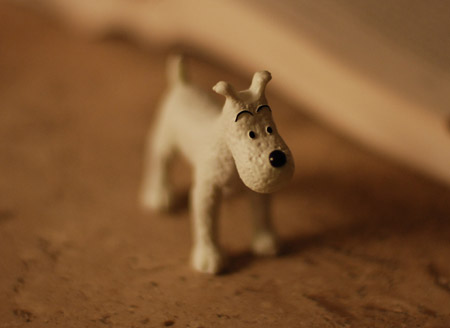
Tintin’s dog Snowy. This figurine is only a couple of inches long, and while his face is in focus, even his front paws are
not. Narrow depth of field is a huge selling point of the 50mm prime lens.
Versatility
Although the 50mm prime has great light versatility, its fixed focal length won’t let you do any zooming, and thus,
you may find yourself too far away at times to capture your ideal shot. Stalkers are well aware of this conundrum.
In order to adequately frame subjects which are far away, you’ll need to pick yourself up a quality zoom lens. Even
among zoom lenses, there is a wide range of versatility. There are 12-24mm (very wide angle), 70-300mm
(very magnified), everything in-between, and even some further down and further out.
The first aftermarket lens I bought for my D80 was a Sigma 70-300mm, thinking it would come in handy for general
use. More zooming would equal less walking and greater detail, or so I thought. In reality, it was a lens I found very
little use for. Its inability to take “normal” wide angle shots, combined with the fact that at 300mm it takes a tripod
to keep it from shaking, made it almost useless to me. I ended up trading it straight across for a Nikon 1.4f 50mm
prime lens on Craigslist, which is much more useful to me (see above section on “speed”).
The most versatile lens in the world — and the one I eventually purchased — appears to be the Nikon 18-200mm
VR lens. I bought this lens onrecommendation from the great Ken Rockwell, and I couldn’t be happier with it.
It does wide-angle shots at 18mm. It does telephoto shots at 200mm. Its focal length essentially covers you in 99%
of the situations you’ll ever find yourself in. And it has VR, which I’ll discuss in the next subsection.
A lot of people have called the Nikon 18-200mm VR the most useful lens ever designed, and it’s not hard to see
why. While professional photographers are used to carrying around a bag full of lenses, prosumers and
weekenders would rather never have to change a lens. With the 18-200mm VR, you just pop the thing on and then
forget about it. It’s a bit steep at $700, but worth it, in my opinion.
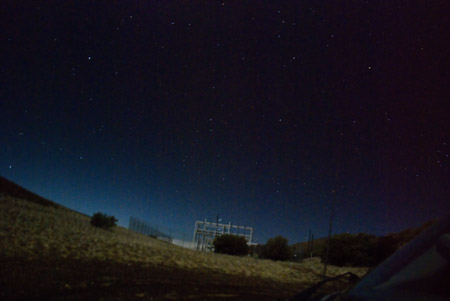
This picture was also taken atop Mauna Kea but under only the light of the moon. This is a 30 second exposure at ISO
1600.
Image stabilization
Both Nikon and Canon have image stabilization built into some of their best lenses now. I haven’t tested Canon’s
out but it’s widely believed to be on par with Nikon’s VR (vibration reduction) technology. In a nutshell, VR is exactly
what you probably think it is: a mechanism inside the lens detects camera shake and moves lens parts around in
order to neutralize it. Does it work? It absolutely does. Is it noticeable? It absolutely is. I took some test shots
around dusk, in low light, both with VR on and off and the difference is dramatic. The shots with VR off are blurry
and unusable. Everybody’s hands have a different amount of shake to them, but most people report the ability to
shoot about 4 stops faster when using VR. That is to say, if you can normally shoot handheld at 1/100, you should
now be able to shoot at 1/15 (in much darker conditions).
As of today, Canon doesn’t appear to have an answer to the 18-200mm VR lens, but perhaps the closest thing
they have is the Canon EF 28-300mm f/3.5-5.6L IS USM, but it’s about $2300. It goes up to 300mm which is nice,
but the Nikon goes down to 18mm, which is more useful in my mind.
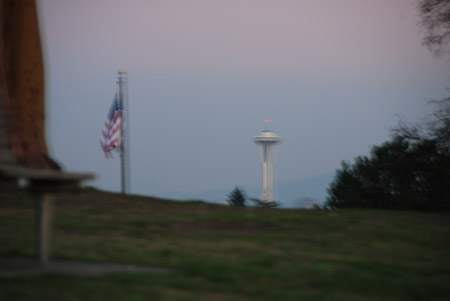
This photo was taken at 1/8 exposure and *no* VR. Blurry.
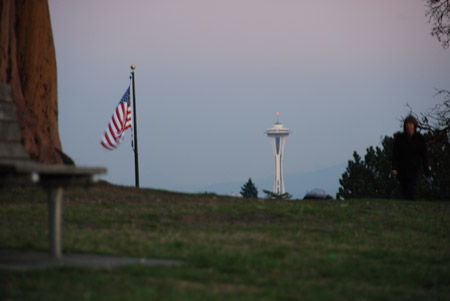
This photo was taken at 1/8 exposure *with* VR. Sharp!
Storage
The D80 uses an SD slot for storage, which I like, but some people prefer Compact Flash instead.
Other models offer the use of either storage technology, sometimes in tandem. Pick whichever format suits you
best, but with the cost of both Compact Flash and SD cards halving every several months, this may not be a
huge factor in your purchasing decision. As of today, an 8 gig SD card can be had for $33.99 while an 8 gig CF
card is about$39 so price per gig is roughly equivalent.
The megapixel myth
Image data is only as good as the source that captured it. In a DSLR camera, that includes both the lens and the
image sensor. We’ve already covered the importance of the lens, but what about the sensor? Is a 6 megapixel
sensor going to produce better photos than a 10 megapixel sensor?
Currently, in most cases the answer is no. For most consumer/prosumer level DSLRs, the compact size of the
sensor is such that megapixel levels above 6 do not increase the quality of the resulting image whatsoever.
Edit (thanksPatrick): The answer is, “not always”. The size and sensitivity of the sensor is more important than the
raw number of megapixels it produces so beware of judging cameras, even DSLRs, on their megapixel counts.
If you’re really interested in fully maximizing resolution and clarity, your only real choices are the new Nikon or
Canon “full-frame” DSLRs. These cameras are all between $2000 and $8000 for the body only and have sensors
which are much larger than any prosumer/consumer cameras. If you’re in the market for one, you’re probably way
overqualified for this article.

High-resolution fire.
Interface and usability
Both Nikon and Canon have spent years refining their user interfaces, and users of each tend to prefer their own
brand. My experience with Nikon was that I spent about 45 minutes reading the manual front-to-back (a rarity for
me), then spent a couple of hours pushing buttons and turning dials, and I quickly felt pretty comfortable with the
D80. Moving from the one-dial-one-button world of a Casio ultracompact to a 100-control DSLR still takes some
adjusting, but as with most Apple products, the dials and buttons on the D80 seem to be designed very thoughtfully
and generally serve their purpose while staying out of your way.
Filters
Most the time, the only filter you’ll ever need is a circular polarizer. Polarizers bend light as they enter the lens to
either reduce or enhance reflections in the scene. They are particularly useful for reducing reflections off of water,
snow, and buildings, and for creating more dramatic looking skies. Polarizers range from about 10 bucks to several
hundred bucks, but most of the reading I’ve done suggests that a $40 polarizer is imperceptibly equivalent to the
much more expensive ones. I use a Hoya that I bought for about $40 at Tall’s Camera.
What’s missing
In my mind, there are only three things missing from most cameras today, all of which I think will become standard
equipment within a couple of years: GPS, wifi, and native HDR handling. GPS seems like a no-brainer and frankly
I’m surprised it’s not more widespread already, considering how small GPS chips have gotten and the fact that a
lot of phones have this capability already. Once all of my photos are automatically geotagged, it will become more
interesting to collect and view them, and thus, I will take more of them. Wifi support is important to me because
I’m often too lazy to transfer my photos to my hard drive or upload them online. Thankfully, a few months ago, the
EyeFi was released, so that’s probably good enough, but it would be even nicer if it was built into the camera itself.
HDR, or “high dynamic range” photography, is a method of photography whereby multiple shots at different
exposures are composited together to produce dramatic, often surreal imagery. Some examples are here, in the
Flickr HDR pool. It seems to me that a camera should theoretically be able to open the shutter once and take
multiple shots from that, each during different points in the exposure, thus producing the layers necessary for the
compositing.
Final analysis
So before you go out and buy a DSLR, here are some recommendations:
- Make sure you want one and have reasonable expectations for its usage
- Keep your ultracompact for everyday use, or buy a new Casio EX-V8
- When looking at DSLRs, trust what the pros use: Nikons and Canons
- Invest more in lenses than in bodies, disregarding any “resolution advantages” that aren’t also
- accompanied by larger sensors
- Purchase both a zoom lens for versatility and a fast prime lens for low light and narrow depth of field
Credits to :